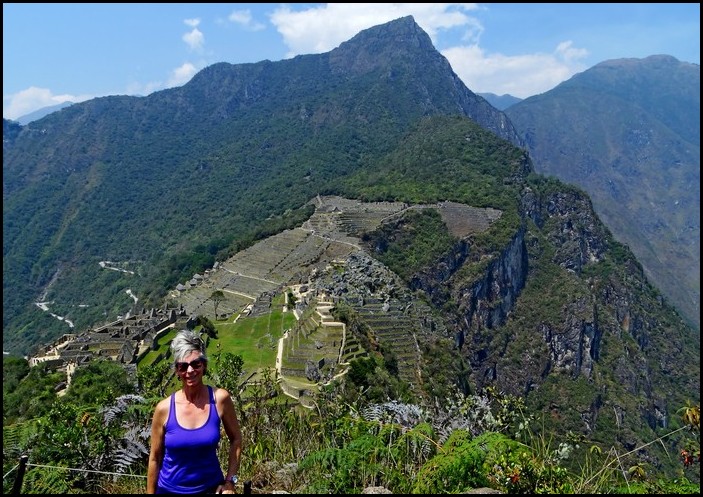
The Full Machu Pichu Experience
Machu Pichu is a place where the experience of visiting live, in person, cannot be captured in photos, no matter how good the images. The ‘classic’ Machu Pichu photo taken from one of the nearby mountaintops, with the visitor towering way above Machu Pichu, is a perfect example.
For one thing, photos can’t reveal just how huge the complex is. Back in its day, Machu Pichu was an entire, self-sustaining Inca city set on several levels of a vast mountain plateau. It’s probably not possible to include the whole city in one single photo. Instead, visitors can see different parts of the city from various angles, heights and levels.
The ‘classic’ photo shows much of the vast complex. But it’s so far below that the city’s huge scale is lost.
Secondly, and what I personally found even more unexpected when I visited Machu Pichu recently, is that photos can’t express the amazing atmosphere and setting of the place. Machu Pichu is way, way, way up in the sky, completely surrounded by a sea of mountaintops. You’re actually standing at the altitude of the mountain peaks, not just the mountains.
So a visit to the Machu Pichu complex is something you really have to experience in person.

However, the actual visit day itself, the morning or half day or full day spent admiring the sprawling and diverse complex, is just one part of the complete Machu Pichu experience. Certainly, that day is the crowning glory. But there’s a lot more involved in visiting the renowned Inca city.
Unlike many of the world’s other ultra-famous historic sites, like the Great Pyramids of Egypt, Taj Mahal in India, Angkor Wat in Cambodia or Borobudur Temple in Java, Indonesia, at Machu Pichu visitors cannot simply walk up to the entrance gate, buy a ticket and enter.
On the contrary, visiting Machu Pichu is a very complicated process that takes a great deal of pre-planning, organizing and co-ordinating. In fact, most people organize their entire trip to Machu Pichu months in advance, sometimes even a year or more, especially for a visit during the high-peak summer months, June-August.
What’s so complicated about visiting Machu Pichu?
Well…
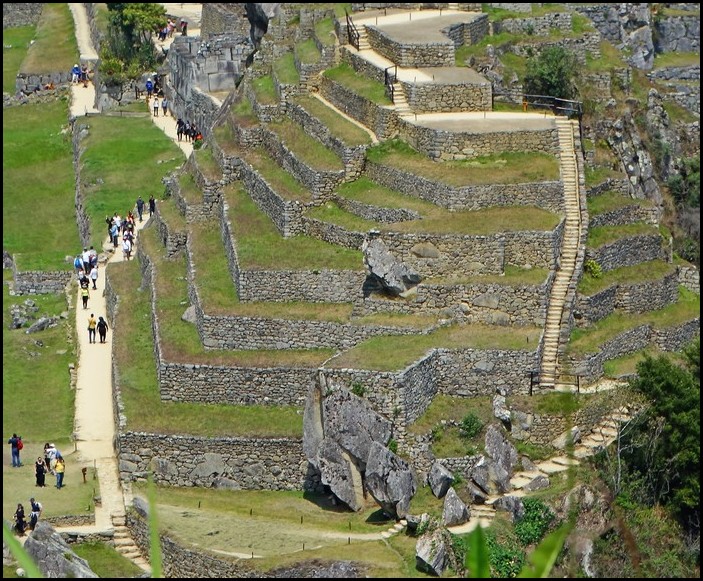
First of all, the Machu Pichu entrance tickets alone are quite complicated. Not only must you buy a ticket for a specific date of the year (usually months in advance), but you must select one of four different types of entrance tickets (regulating which parts of Machu Pichu and/or nearby mountain peaks you can visit) and also choose exactly which time of the day you’re allowed to enter.
With that ticket you must arrive at Machu Pichu on the designated day and at the designated time. They give you a one-hour leeway. Outside of that hour, you will not be admitted.
Secondly, getting to Machu Pichu is not so simple. There are no roads to Machu Pichu. All visitors must either make a 3-4 day high-altitude trek through the Andes or else take a very expensive train in and out.
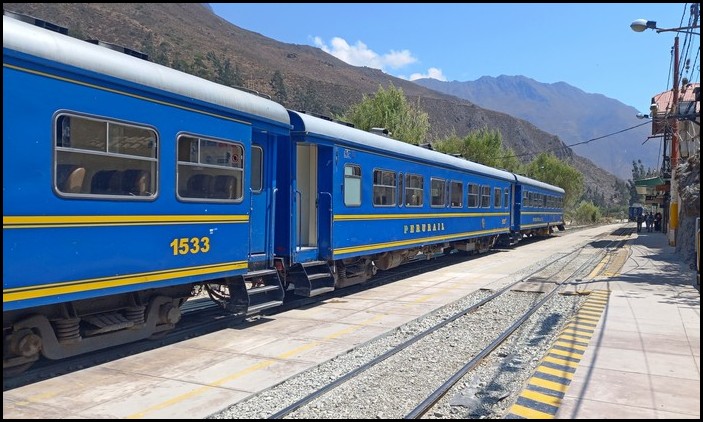
Obviously most people are going to take the train. That means buying the train tickets for the specific days they’re going to ride in and ride out. The hiking option entails preparing personal gear for the trek as well as co-ordinating accommodations along the route, and co-ordinating that with the entrance ticket date.
Clearly you also have to co-ordinate the date of your entrance ticket with the day of your train or hiking arrival day and your accommodation at least for the nights before and after your day at Machu Pichu.
There’s one other step as well. The train or the 4-day hike will land you at a small tourist village set at the base of the mountain where Machu Pichu is located. It’s called Machu Pichu village or Aquas Calientes.
From there you need to take a (very expensive) bus that zig-zags up the mountain to the site. So you also must buy a bus ticket in advance (at least the day before) and co-ordinate your bus ride time in order to arrive at the entrance gate at your designated entry time.
There’s more!
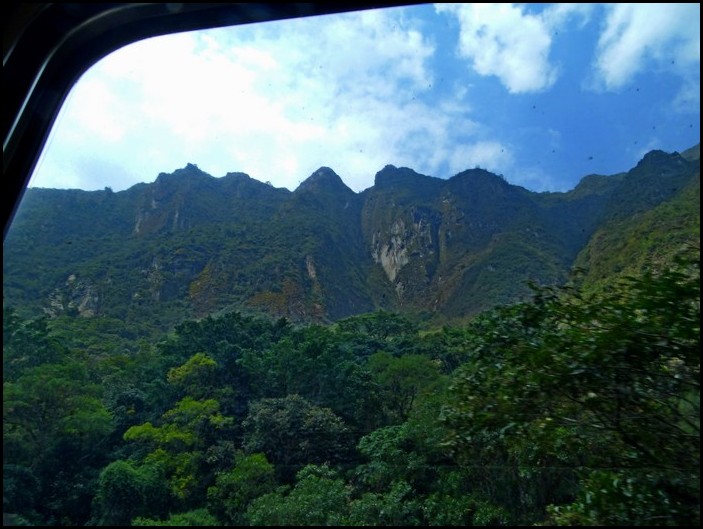
If you’re arriving to the Machu Pichu region from overseas, then of course you must also co-ordinated your flight into Peru and to Cusco (closest major city to Machu Pichu) with all your other Machu Pichu arrangements.
Added to that, you also have to factor in the high altitude. Specifically, you must be prepared for the physical affects of high altitude and the potential that you’ll have at least mild altitude sickness.
Whew! There’s a lot involved in visiting Machu Pichu!
I have to admit that I wasn’t actually aware of most of what I’ve just outlined above until about two weeks before my visit to Machu Pichu. I was already in Peru, and in fact, already at Cusco when I learned online about the entrance tickets, train or hiking option and so on.
Luckily, I was visiting in September when the high tourist season was winding down. So I was able to find an entrance ticket, train tickets and accommodation in Machu Pichu village a couple weeks before I headed in. I think that I would have been out of luck if I’d been trying to visit in July or August.
Quite luckily, when I finally did start a detailed research, I quickly discovered a website that explains in great detail exactly how to go about buying an entrance ticket and the four different types of tickets. The site also explains exactly how to buy the train tickets.
Instead of repeating all of that detailed and most excellent information in my article here, I’ll just refer you to the website here. Look there for detailed instructions on buying tickets for the trains and entrance to Machu Pichu.
In this article, I’m going to go over my own experiences of taking the train, staying in Machu Pichu village, taking the bus, visiting Machu Pichu itself, and taking the train back out.
Overview of the journey – getting to Machu Pichu
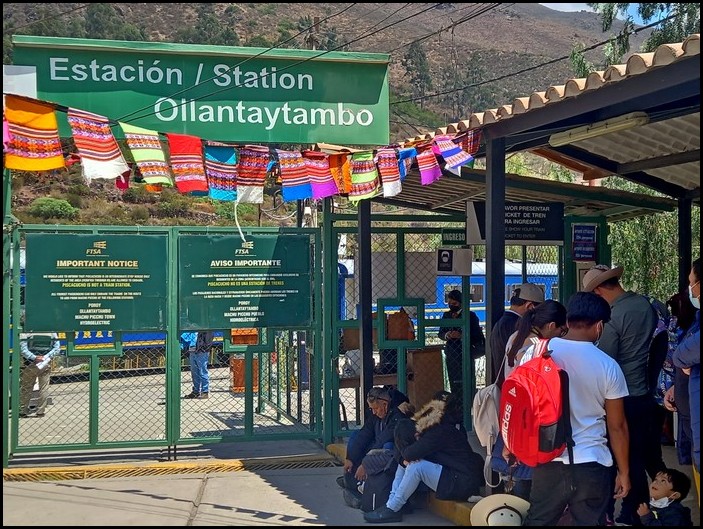
The train trip
Two train companies offer trains to Machu Pichu village, Peru Rail and Inca Rail. Both have pretty much the same prices, journey times, services and – supposedly – luxurious trains.
As I mentioned earlier, these trains are ridiculously expensive, especially when you consider that it’s Peru – not Europe or USA – and the trip is only 1.5 hours and several trains per day are running.
I paid a total of about $110 US for my round-trip tickets. But that was one of the lowest prices I saw. Most other options were considerably higher, some double price.
Keep in mind that I visited during September, well after the high season. Prices during June-August are certainly even higher. For the same trip. Both train companies know they have a corner on the tourist market and the government doesn’t restrict them in any way on their prices. So they really gouge all the visitors!
I certainly wasn’t happy about the high-priced train tickets. But I had to just suck it up, like everyone else who goes to Machu Pichu.
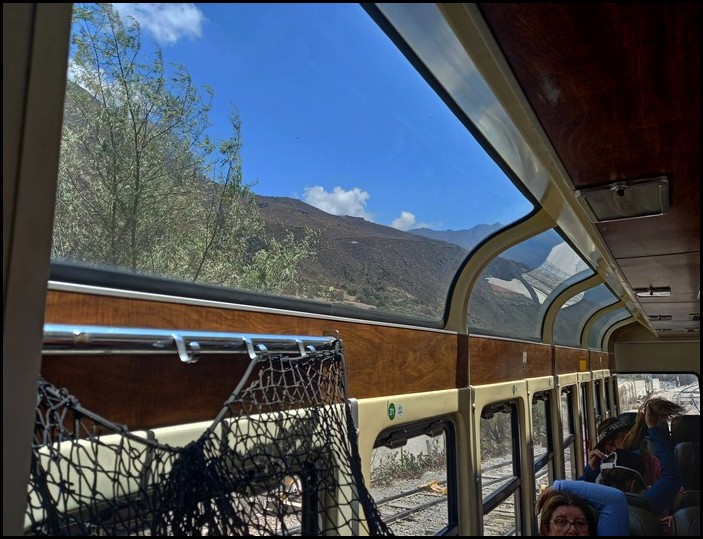
The ‘luxury train’ experience
I consoled myself that since I had to pay for a ‘luxury’ train to Machu Pichu that I could at least a luxurious journey.
Photos of all the trains show very sleek train cars with extra-big, plush seats; wood panelled walls; immaculately-uniformed train attendants and giant windows along the sides and tops of the trains, for providing spectacular views of the Sacred Valley and Andes mountains. They also said audio recordings provide information about the sites along the route.
However, a tiny tiny footnote at the bottom of the train ticket booking page says that each passenger can only take 5 kg / 11 lbs of luggage with them! What?!!! That’s no weight at all! That’s like one tiny over-night bag, with no change of clothes and limited toiletries.
For a train ticket that costs as much as a flight, they have the nerve to limit passengers’ luggage to almost nothing?! Completely outrageous!
So I went to the Peru Train station office in Cusco to ask about carrying more luggage. The attendant seemed to think it would be ok for me to take one larger bag/backpack.
But to be extra-sure, I actually visited my departure train station in Ollantaytambo to ask. Turns out, they actually have a free luggage storage room at the station so that passengers with more luggage (almost everyone, of course) can leave most of it behind. At least that’s included in the over-priced tickets!
I actually went to visit quaint Ullantaytambo the week before my trip to see the village’s huge Inca archaeological site and super-cute Inca village. A side-visit to the train station was easy to include.
So before I arrived at the train station in Ullantaytambo I already knew the station and area leading up to it would be very touristy and crowded.
So I arrived in plenty of time to drop off my luggage, get onto the platform and await the train. That all went smoothly.
But once I got inside the train, I was highly disapointed. Sure, the seats were big and plush and comfortable. And the huge ceiling-top-wall windows were great for viewing passing mountains.
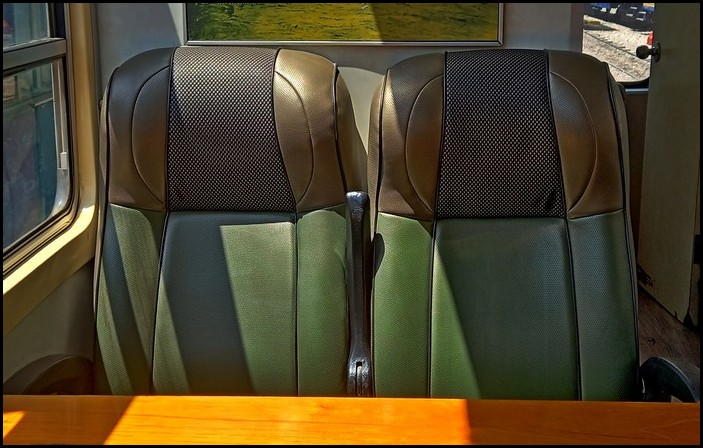
But that was the limit of the so-called ‘luxury train service’. The aisle was extremely narrow. The interiors were in poor condition. And the toilet was no better than any normal train in countries like Thailand, Malaysia and Romania.
In fact, besides the special windows, the train was comprable to any 2nd-class train I’ve taken in many countries of the world. And those trains cost me about $5-10 US for a 6 to 8 to 12-hour journey!
Then there was the service…or lack of service, to be exact. First of all, they did not offer any refreshment whatsoever! You’d think for such an over-priced, so-called luxury journey that they could manage to serve one free beverage, like a bottle of water or coke or juice, and maybe a small pack of crackers or cookies or sandwich. No! Nada!
I’ve taken luxury buses in Mexico, Ecuador and other countries. During the journeys, bus attendents come around providing free beverages and snacks. And those journeys were certainly much, much less expensive than the Machu Pichu train!
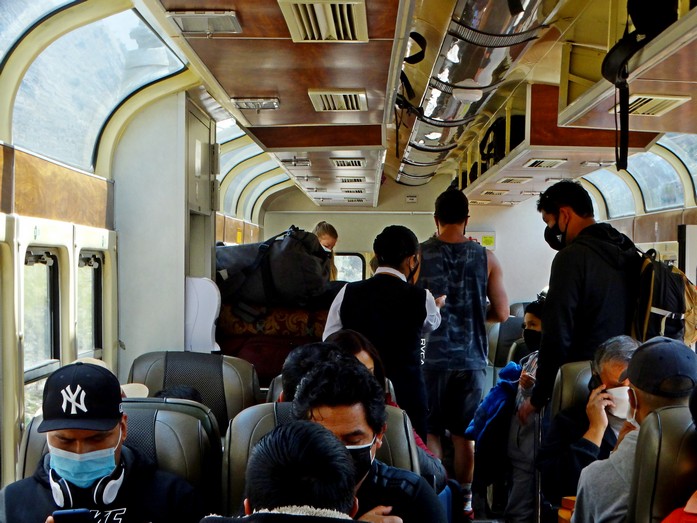
I think that at least some nominal drink/snack offering should be included.
Secondly, there was no audio recording providing information about the sites or mountains. Nor of Machu Pichu. Or anything. Nada.
Even worse, the train attendants didn’t know the answers to any basic questions! I asked a few times about the mountains and Sacred Valley we were passing through. The attendant didn’t know anything! Nor did she try to find out the information from her colleages for me.
Complete lack of service is what I’d call that trip.
It was even more galling since the company claims to be a luxury train and claims to provide services that it doesn’t.
I was very much under-impressed. Negatively impressed, in fact.
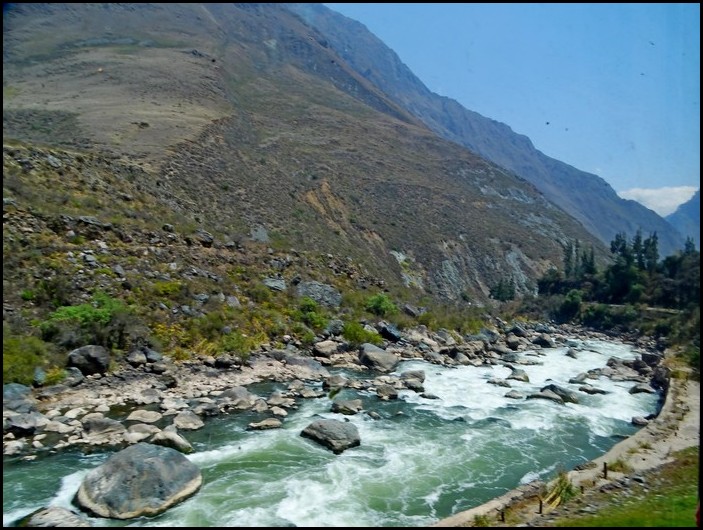
The train journey through Sacred Valley
Quite happily, unlike the ultra-crappy service and lack of claimed luxury, the scenery through Sacred Valley was really spectacular. That part exceeded my expectations.
From Ollayntaytambo to Machu Pichu village, the valley floor drops 3000 ft / 1000 M. That’s a pretty huge drop in elevation for a train, and so we were mostly heading downhill for the whole journey.
Just out of Ollantaytambo, the Sacred Valley was more or less the same as the regions around Ollantaytambo, Urubamba and other parts of the valley I’d already explored.
It’s a wide flat valley lined on two sides by high mountain ridges. Urubamba River flows through it and the valley floor is filled with agricultural fields, scattered houses and villages.
The climate and vegetation are very dry and arid. Soil and rocks all look very dry. Most plants are arid types.
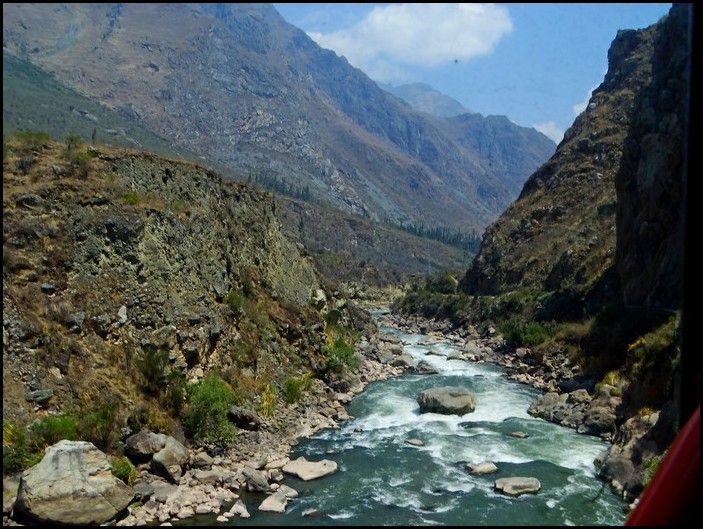
Soon after leaving Ollantaytambo, the valley began getting narrower and Urubamba River became more wild, rough and rock-strewn. The mountains squeezed in and the valley became a lot more rugged.
Eventually, it turned into a deep gorge with a raging river running close beside the train. The mountain slopes shifted into high cliffs, the mountain peaks became higher. At one point, several ultra-high snow-capped jagged peaks could be seen in the distance. The highest are over 20,000 ft / 6000 M.
About one hour into the trip, while enjoying views of the wild river, I suddenly noticed that everything was really green. As I looked around, I realized the vegetation was a lot more dense and jungly.
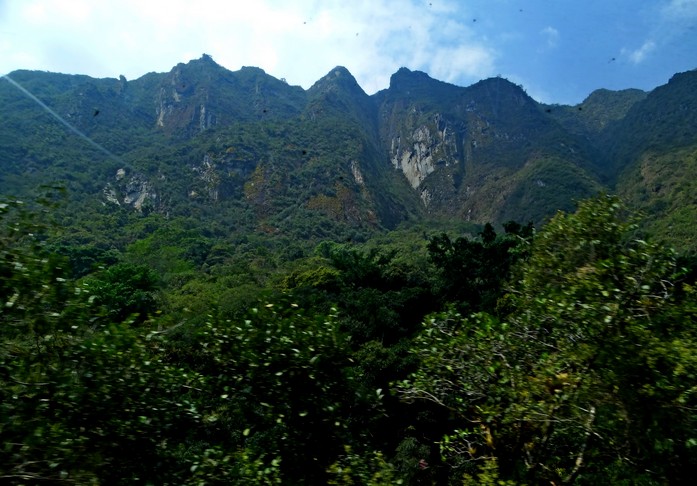
As we continued on closer to Machu Pichu village, the trees, bushes and other vegetation became distinctly tropical! We had left the arid Sacred Valley behind and entered a much warmer – even hot – and humid tropical jungly paradise!
Not only had we changed elevations considerably, we’d changed climate and vegetation zones during the 1.5 hour journey. We landed in the middle of a lush, tropical jungle mountain zone!
I later learned that that region is technically called Tropical Highlands.
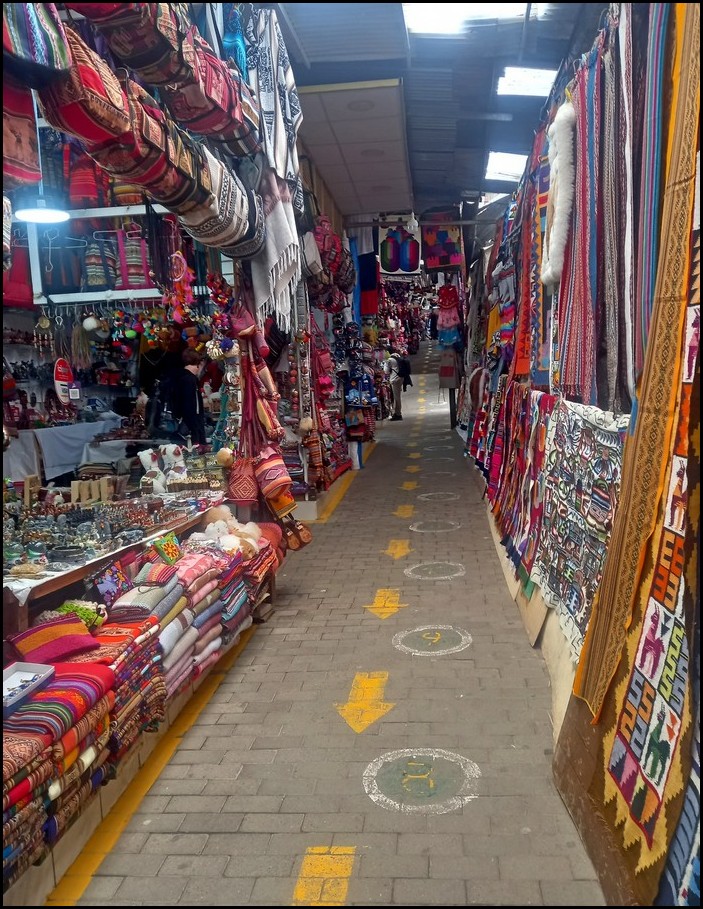
Machu Pichu village
We ended our train trip at tiny Aquas Calientes, aka Machu Pichu village.
It’s a fairly crappy, entirely tourist-driven village filled with souvenir shops, tour agencies and restaurants, cafes, bars and small hotels all geared to tourists. It’s densely-packed with ugly cement buildings, tourists and hordes of noisy children running around.
It’s pretty much what I’d expected, so I wasn’t too shocked. Though I was surprised about the sheer amount of noisy, screaming children all over the streets. I was told the kids are allowed out because it’s so safe there.
On the other hand, the village has a stunning natural setting at the confluence of two rivers. The main river, Urubamba River, is the same one the train follows to the village. The second smaller stream flows steeply downhill through the middle of the village.
Soaring, jungle-clad mountains pack in closely around the town. And a dirt road runs along the main river to a bridge, where the road starts chugging up the mountainside to Machu Pichu. This is the bus route and the only road.
There are some enjoyable things to do in Aquas Calientes. Several trails lead to various waterfalls. The village is named for the natural hot springs there, which are located a short distance out of town (and uphill). The hot springs site has another waterfall and spectacular moutain views. Unfortuantely, the water is just tepid at 37C (body temperature).
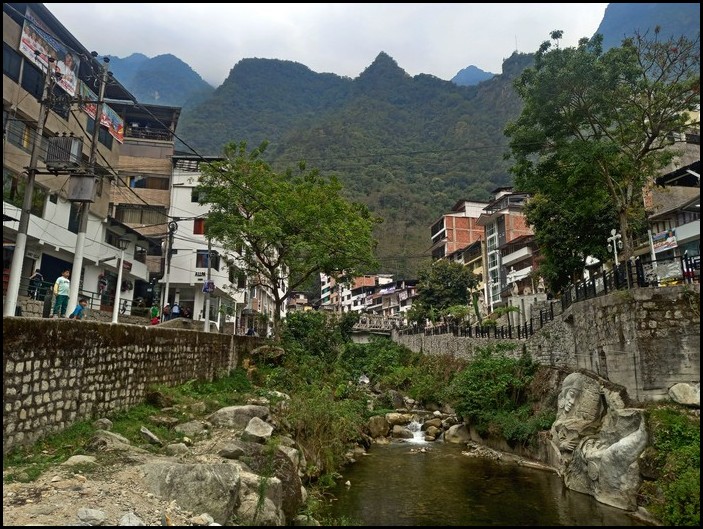
Near the bridge I mentioned earlier, across the river, is the small but very informative Machu Pichu Museum. You must present your entrance ticket to Machu Pichu to get in the museum, but it’s well worth the walk and time. Well-made displays explain a great deal about why the Incas built the city at that location, different areas within the city, how it was built, the water canal system, Inca beliefs, and other things about Machu Pichu.
Aquas Calientes also has some excellent restaurants and bakeries, so you can certainly eat well there.
So for travelers with extra time and interest, it could be worth spending 2-3 days in Aquas Calientes, around your visit to Machu Pichu.
I spent four nights, 3 ½ days in Aquas Calientes, but that was partly due to having two luxury hotels to visit as work. Without that work, one night and day less probably would have been enough.
During my stay I visited the museum, hiked to two or three waterfalls, walked along the train tracks, visited the hot springs and ate a delicious authentic Italian pasta & cocktail to celebrate my visit to Machu Pichu. Speaking of which, one day was obviously devoted to visiting Machu Pichu.
Hiking to/from Aquas Calientes to Machu Pichu
Before I get into the crowded bus experience. Let me point out that it’s possible to hike up to and down from Machu Pichu on a steep mountain trail. The trail starts on the other side of the river, near the bridge and bus route up the mountain.
To make that hike, you must walk from town to the trail and then up the mountainside. It’s a 2 km hike, but takes 1-1.5 hours each way. For hikers and fitness buffs, this could be a good way to save $24 US on the 30-minute bus trip up and down the mountain.
But keep in mind that you’re going to be hiking around the huge Machu Pichu complex for 3-4 hours, carrying water, possibly camera gear and, if you’re smart 1-2 meals and clothes for various weather conditions.
Adding the extra hike up and down the steep mountain might be a bit much. Every person I saw returning from the mountain trail was completely wiped out exhausted and deydrated.
Another option would be to take the bus up the hill ($12 US) and then hike back down the mountain.
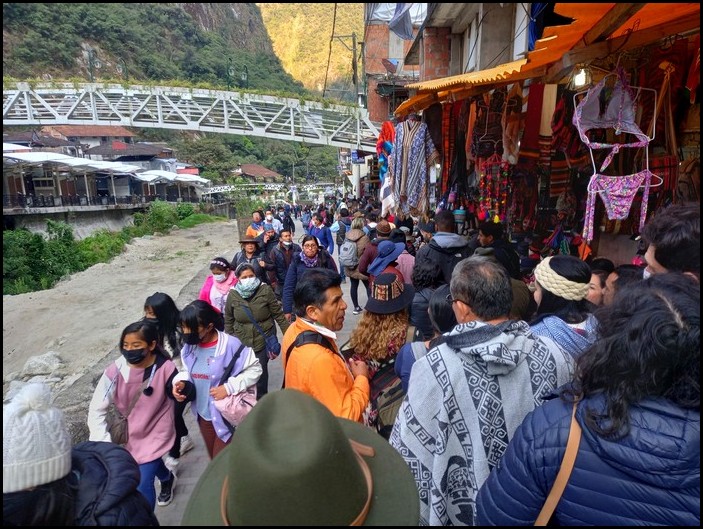
Catching the bus
Obviously, most people are going to take the bus. Even I took the bus, fitness nut that I am!
In my case, I had to visit Belmond Sanctuary Lodge for work, situated at the entrance to Machu Pichu, on the same day as my Machu Pichu visit. I also had an incredibly heavy bag with two full meals, 2 liters of water and my camera. I knew it would be too much for me to hike up and down the mountain on top of spending four hours climbing around Machu Pichu and then working at Belmond Hotel.
I bought my bus ticket the day before my trip so that I wouldn’t have that extra step on the day. Note that the bus ticket office is in a slightly different location than the bus stop and the lines at the ticket office can be long. So I recommend buying your ticket in advance.
The bus office recommends that you arrive at the bus stop at least one hour before the time of your Machu Pichu entrance ticket. The bus itself takes about 30 minutes to zig-zag up the mountain, so I was kind of wondering why they tell you to start so early.

My entrance ticket was for 8 am. So I planned to reach the bus stop between 7-7:30 am. I arrived at 7:15 am and…
OMG! I was absolutely flabergasted. The street with the bus stop was completely jam-packed with hordes and hordes of people. For blocks and blocks and blocks. That was the line for the bus! At 7 am! Holy SH**T!
So, yeah, you really do need to be at the bus stop at least one hour before the time of your entrance ticket.
Happily, the waiting hordes were in good spirits, calm and patient. The lllloononnngggggg line very slowly inched its way forward…and in about 40 minutes it was my turn to board the bus.
The bus, of course, was completely crammed. But, once again, everyone was calm and patient. We soon were zig-zagging up the mountainside. Towards the top we began having some spectacular mountain views peaking between all the dense tree foliage…and in 30 minutes we reached the entrance…where…
…there was another massive swarm of people waiting to get into the entrance gates.

The Machu Pichu Inca Ruins experience
After getting through the correct entrance gate for my particular type of ticket, I followed along a trail beside a rock wall until I reached the actual Machu Pichu site. I arrived from the side on a lower level of the vast complex.
This brought me to a series of reconstructed stone houses with thatched roofs on the edge of the site. From there I caught my first glimpses of Machu Pichu…I was on the far side of a large plot of stone terraces that filled up an entire steep hillside. At least 30 terraces marched up and down the mountain.
Beyond the terraces I could make out a huge grassy plaza, several stone buildings of various shapes and sizes, and more city complex up above on other levels of the mountain plateau.
That’s when I got my first inkling of how huge the Machu Pichu complex is. It stretched on as far and as high as I could see, but I couldn’t see all of it.
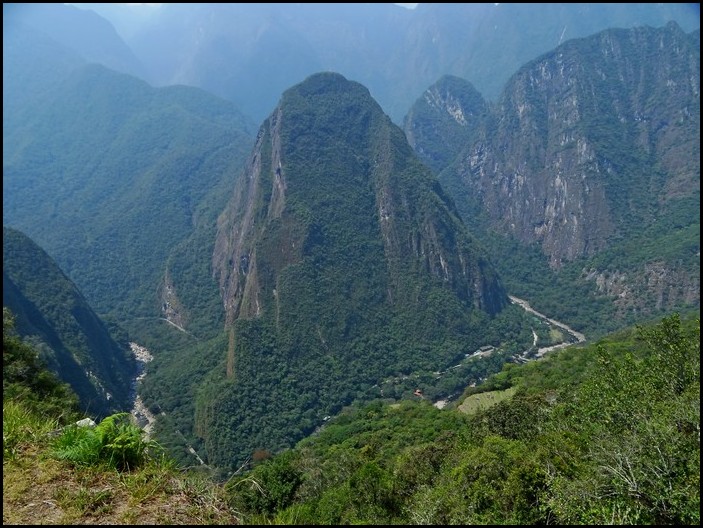
When I stepped out onto the edge of the terraces, I was overwhelmed by a vast sea of mountaintops, seemingly floating way up in the sky, and practically all around me. This, to me, was the most amazing aspect of Machu Pichu.
The nearly endless sea of mountaintops floating across the horizon provides a phenomenal ambiance and experience, as if you’re way up in the heavens.
Considering that the Incas believed the mountains were divine spirits, I can only guess how they must have felt living way, way up in that lofty mountain domain. I’m sure for them it was an even more blissful and reverent experience than mine.
My particular entrance ticket allowed me to walk through sections 1 & 2, the two lower parts of the complex. I was also allowed to hike up the smaller of three mountain peaks to enjoy bird’s eye views of Machu Pichu.
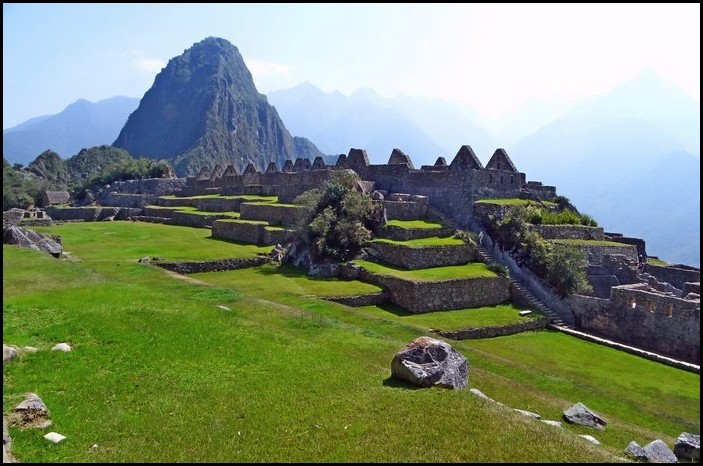
The lower two sections are quite extensive and took me at least two hours in total to explore. I’m sure I could have easily spent more time, but I had a hotel inspection visit in the afternoon, which put a cap on my visit time.
The two lower sections included visiting reconstructed houses, grain storage buildings, several expansive terraced fields, the Sun Temple, the Moon Temple, the Condor Rocks, a massive open grassy plaza and several other stone buildings. All were connected by a series of stone stairs leading up and down the vast mountain plateau.
Along the way, I caught snippets of guide explanations. Much of the information I’d already learned at the museum, but quite a bit more was new to me.
Guides are available down in the village as well as in front of Machu Pichu entrance. Anyone who wants to pay the extra fees and learn all the intricate details of the site can certainly get as much out of their visit as possible. I declined hiring a guide, mostly due to the cost.
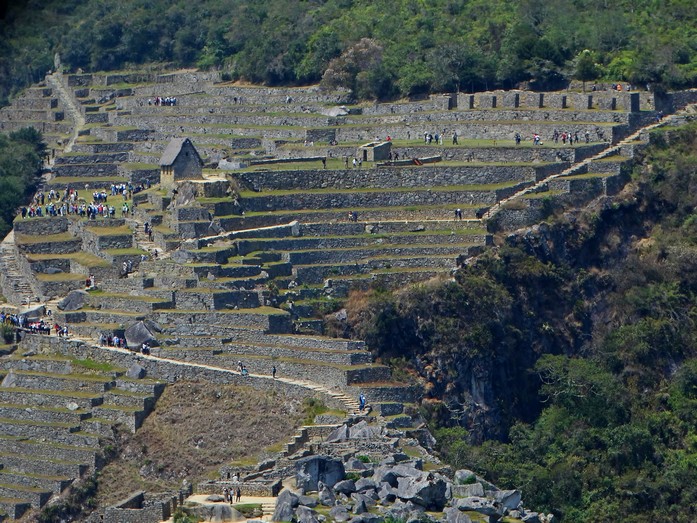
After slowly exploring most of sections 1 & 2, I reached the far side of the complex and the entrance to my short mountain hike. There, a guard at a booth checks everyone’s tickets to advise them which mountain path to take, check their entrance time (if you’re too late according to your ticket slot, you might not get in), register visitors to enter, and sign them out when they depart.
Much to my surprise, the mountain trail was left in its natural forest and rock state. It was just like hiking out in the wilderness. The trail was perfectly easy to follow, climbing steeply up the short spiky mountain. It took about 30 minutes to reach the top.
Along the way, ever-expanding views of Machu Pichu and the surrounding mountains unfolded until I finally reached the high, bird’s eye view shown in my photos above.
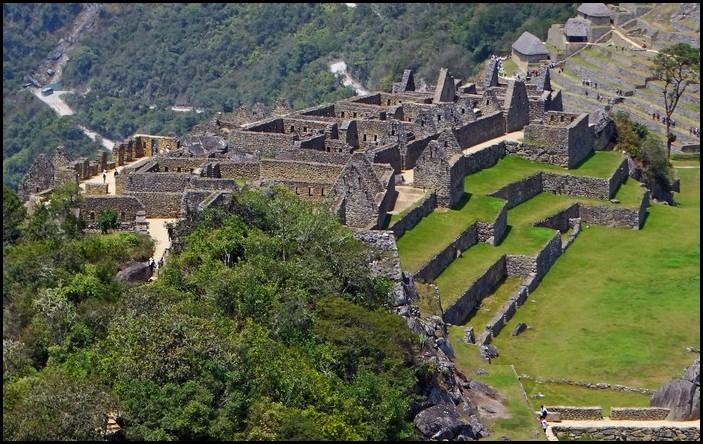
I parked myself on a rocky outcrop overlooking the huge, multi-level complex and stayed there for a full hour, enjoying the amazing panoramic views. This is what everyone comes to Machu Pichu to witness, after all! it was wonderful.
Eventually, I climbed down, back into the main complex. From there, more walkways lead me through even more of the lower two levels. I saw the crazy Condor Rocks, which the Incas believed looks like a condor taking flight. I enjoyed more panoramic seas-of-mountains vistas and passed through more stone terraces. The paths eventually lead me back to my original entrance point.
There I took my last lingering glmpses of the incredibly impressive Inca city in the sky.
…and I headed back to the crowded bus drop-off / pick-up zone to board another jam-packed bus to zig-zag down the mountain to the village.
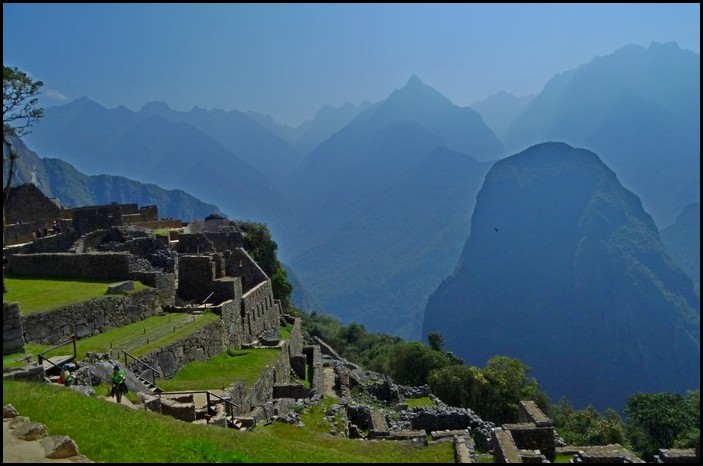
A few important notes to keep in mind
* Toilets
There are no toilets inside the vast Machu Pichu complex! None. So be prepared.
There are public toilets just outside the entrance gates. And that’s it. So be sure to use them if you will need a toilet within the 3-5 hours that you’ll be exploring Machu Pichu.
I did find that it was easy to pee in the bushes and rock crevices on the mountain hike. So if you don’t mind peeing the ‘wilderness’ that’s a chance to relief yourself during your tour. I assume there are similar pee-spots on the other two mountain routes.
* Meals
It’s prohibited to eat inside the complex! So be sure to eat before and/or after you exploe Machu Pichu. There’s a restaurant/cafe outside the entrance and an expensive, upscale restaurant inside Belmond Hotel, located near the entrance. Or take your own meals like I did.
Visitors are allowed to carry water and beverages. In fact, you’d better carry plenty of water for the long, vigorous hike through the complex.
When I was atop the mountain peak enjoying the views, I did drink my coffee and eat some chocolate. I saw other visitors chewing on power bars and snacks. I’m pretty sure you’d be able to eat a full packed lunch there without any disturbance as well.
So it’s possible to go around the rules a bit if necessary.
* Hydration and Sun Protection
Like any mountain hike, be sure to carry plenty of water. Electroyles would be even better.
Check the weather for the site before you head up! The conditions are quite variable. It could be cold, cloudy, rainy. Or it could be very hot and sunny. Or both! Check first and go prepared.
For sunny days, cover up from the very sstrong, intense sun, either with clothing or sunscreen and some sort of hat / face protection. It can get very hot midday during clear weather and it’s easy to burn up in the higher altitudes of the mountain.
For cloudy and/or rainy days, take clothes for cold weather and/or rain. Machu Pichu site is several degrees colder than down in the village most of the time.
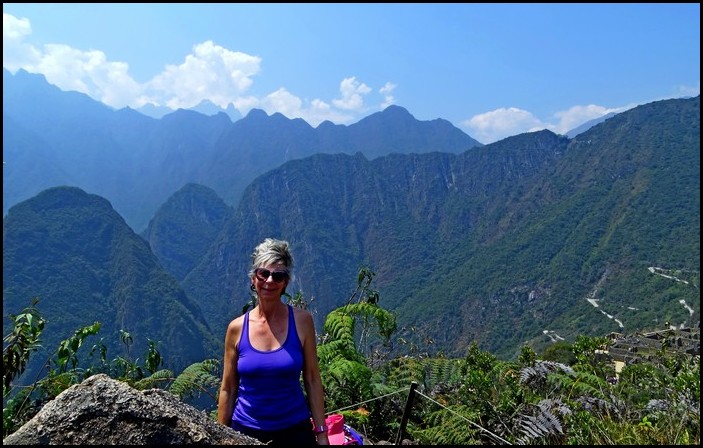
Summary
Machu Pichu is deservedly one of the great Man-made Wonders of the World. It’s a place whose experience you can only really get in person.
It’s a place that’s not easy or quick to reach. There are massive crowds to deal Math. And it’s expensive, no matter how you do it. Visiting Machu Pichu takes a lot of pre-planning and organizing.
Despite the difficulties and complexities, however, Machu Pichu is most definitely worth visting.
=========================
You might also like:
Introduction to the Amazing Sacred Valley of the Incas
Introduction to Cusco
========================







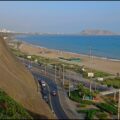
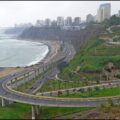



 Hi! I'm Lash, an American nomadic world traveler who's been traveling solo since 1998. I’m passionate about traveling the world nomadically and then sharing it all with you. I hope to inspire you to travel the world, to entertain you with tales from the road, and to help you reach your travel dreams. Welcome!
Hi! I'm Lash, an American nomadic world traveler who's been traveling solo since 1998. I’m passionate about traveling the world nomadically and then sharing it all with you. I hope to inspire you to travel the world, to entertain you with tales from the road, and to help you reach your travel dreams. Welcome! 



